created: 02-25-2021.
revised: 02-25-2021
From 1609 to 1612, Galileo conducted the first survey of the night sky using a telescope.
Galileo straddled the old world of a natural philosopher, and mathematician, to that of the new world of modern science, and made fundamental contributions to science by his groundbreaking inventions and discoveries.
He was one of the first to pioneer experimental scientific methods and in 1610 was the first astronomer to build and use a telescope and move the science of astronomy into a new age.

Galileo - the First Optical Astronomer! PDF
While it is not certain whether Galileo was actually the first person to use a telescope to observe the heavens, he was the first to document and publish the new discoveries of what he observed with it.
As his skill in creating telescopes with better optics improved, he began to turn the new instruments towards the sky.
Galileo's best instrument had a 1 3/4" inch convex objective (stopped down to 15mm) with a focal length of 980mm in a 49" paper tube using a concave 'eyepiece' of 22mm, giving a magnification of 20x.
By late November of 1609, Galileo had seen enough to convince him to begin a systematic research project of the heavens, starting with the Moon, using his best glass.
By January of 1610, the 45 year-old Galileo had made a number of spectacular discoveries in the night sky using his telescope.
In addition to discerning surface features on the Moon,
these discoveries included first three, then four new 'stars' that appeared to follow Jupiter and changed locations and alignments to one another each evening.
He also resolved the glowing clouds of the Milky-Way into countless individual stars.


Galileo documented these discoveries and published them in a 24 page pamphlet in March 1610 titled the "Starry Messenger" or also called "Sidereal Messenger" (Sidereus Nuncius).
This was the first scientific book based on astronomical observations made through a telescope!
In some respects, the "Starry Messenger" really wasn't a book;
it was more like an 'announcement' of newly discovered celestial phenomena that was revealed by his telescope.
Galileo's style in writing it was not as dry formal textbook,
but more as a conversational first-person perspective of the excitement of his discoveries.


Galileo's Observations:
In his book, Galileo included sketches along with his written descriptions. Below you will find examples of those sketches.
In the table to the left, you will find examples of my 'Galilean' observations made over the years.
In keeping with the 'spirit' of Galileo, most of my observations are sketches made with a small telescope, but a few are video-capture images.
The Moon:
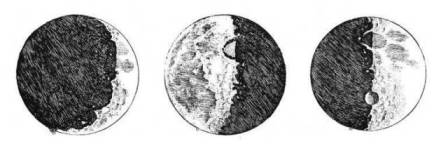
The 'Fixed Stars':
Including M45 - 'Pleiades', M44 - 'Praesepe', and Orion's Belt & Sword
(note - I've highlighted in yellow the naked-eye stars to better visualize what Galileo was the first to see thru his telescope)
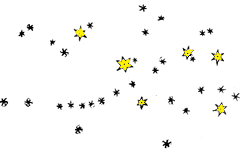
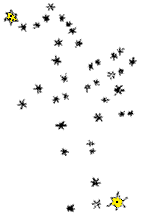
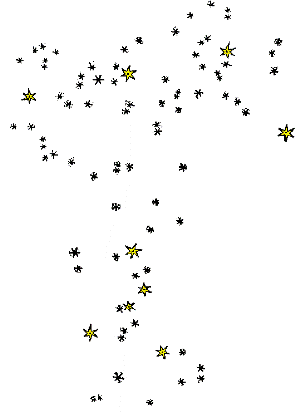
The Medicean Stars: (Jupiter's Moons)

Galileo later went on over the next several years to be the first to observe and publish additional observations on the phases of Venus, Saturn, and Sunspots
which he published in 1613 in a pamphlet titles "Letters on Sunspots".
Saturn's Rings:

The Phases of Venus:

Sunspots:

The 'Scientific Revolution' is said to have begun with the Copernicus sun-centered model in 1543 and concluded with Isaac Newton publishing his "Principia Mathematica" in 1687.
Galileo lived and made his groundbreaking scientific contributions during this time.
A late day 'Renaissance Man', who helped lead the science of astronomy into the 'Age of Enlightenment'.
Galileo's celestial observations changed the way people thought about the universe, and our own world.
His invention of the first true "telescope" and turning it to the night sky overthrew the geocentric world-view and transformed our cosmic perspective:
* Our Moon was another feature-filled world just like the Earth.
* The Milky-Way was countless far-away stars.
* Other Moons rotated around Jupiter.
* Venus showed phases, just like our Moon.
* The Sun was pocked-marked with changing spots.
And ALL of it rotated around the Sun. Copernicus was correct; the Earth was not the center of all cosmic motion and itself rotates around a blemished Sun that was not a changeless orb.
The Ptolemaic System was up-ended.
All these discoveries by Galileo led to a NEW 'Renaissance' in Astronomy, and a new understanding of our place in the Universe that continues to this day.
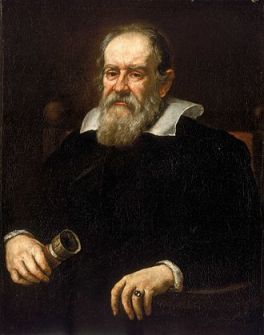
Hope you enjoyed the visit. Come again soon!
Larry McHenry, Pittsburgh, PA. USA
Astronomical Webportal:














